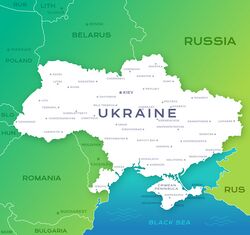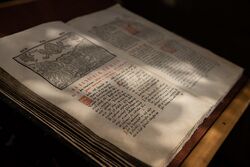Ukrainian genealogy involves researching ancestors from Ukraine, one of the larger European countries located in the east, bordered by Russia, Poland, Belarus, Romania, Moldova, Slovakia, and Hungary. The country has an estimated population of about 37 million people.[1]
Awareness of Ukraine's geopolitical situation has increased in recent years due to the Russian war that started in 2022. Ukraine has been known as “the breadbasket of Europe” for many years due to its high production of wheat.[2] Over the years, the people of Ukraine have emigrated to areas such as other former USSR countries, Canada, Poland, United States, United Kingdom and Brazil.[1]
The complicated history of Ukraine

Ukraine has struggled for its own identity and its borders have changed many times over the course of history. The country only became independent when the former USSR dissolved in 1991. Ukraine also was temporarily an independent country from 1917 to 1922 and then it was merged into the USSR.[1] The area from Pereiaslav (now the Kyiv Region) to Galicia (now western Ukraine and eastern Poland) was first noted as Ukraine in the 1180s.[2]
Over the years, the treatment of people in Ukraine has been cruel. Jewish people faced persecution and were killed in pogroms. The pogroms were documented first in 1859 and as late as 1921.[3] Many more Ukrainian Jews were killed in the Holocaust perpetrated by the Nazis during World War II.
Then the Soviet government went after the rural farmers and villagers with a man-made famine called Holodomor from 1932-1933. Scholars estimate that between 3.5 million and 7 million people died from hunger. Some experts believe the death toll could be even higher than 7 million people.[4]
Many Ukrainians faced persecution for false crimes during the Soviet era, and were executed or sent to the gulags to perform forced labor, which later killed many of them.
Ethnicity in Ukraine
Ukraine's population is mostly Ukrainian, with almost 78% identifying themselves as Ukrainian in a 2001 census. Another 17% reported themselves as Russian and 1% identified as Jewish. The ethnicities that were reported under 1% included Belorussians, Moldovans, Crimean Tatars, Bulgarians, Hungarians, Polish and Pontic Greeks.[5]
Back in the mid-1920s, a census found about 80% of the population was Ukrainian, 10% was Russian and another 5.5% was Jewish.[2]
Religion in Ukraine
A survey conducted in 2018 studied the religious background of Ukrainian citizens. The majority of believers (87%) identified as Christians, with 67% identifying as Orthodox, 10% as Catholic (both Greek Rite and Latin Rite Catholics) and 2.2% as Protestant. Almost 8% did not identify with a particular sect of Christianity and another 0.4% identified as Jewish.[5]
Ukrainian language

Ukrainian uses Cyrillic letters, which also are used in more than 50 languages.[6] Some letters in the Cyrillic alphabet may look familiar to speakers of languages with a Latin-based alphabet, but most of these letters make different sounds. The Ukrainian alphabet has 33 letters.
While there are similarities between the Ukrainian and Russian languages, there are notable differences as well. For example, the months of the year have different names in Ukrainian than they do in Russian.
The Ukrainian language has struggled to maintain its status as the vernacular, with a noticeable percentage of people speaking Russian in Ukraine. A census in 2001 found that 67.5% of Ukrainians identified Ukrainian as their primary language while 29.6% said Russian was their primary language.[5] Ukrainian only became the only official language of Ukraine in 1989.[6]
Historically, the use of Ukrainian was challenged in the Russian Empire. In 1876, Czar Alexander II issued a secret decree unknown to the general public (Ems Ukase) that banned the use of Ukrainian in publications, theater productions, and public performances of songs, and forbade the import of Ukrainian-language books. The restriction on theater productions and public performances of songs was lifted in the 1880s. Czar Nicholas II reversed the ban on Ukrainian publications in 1905, but after the 1905 Revolution, Ukrainian organizations were harassed and Ukrainian publications were closed.[2]
Records at Ukrainian archives
Researchers can find censuses, metrical records, school records, court records and many more types of records in Ukraine. Once churches and other places of worship were closed by the communist government in the 1920s and 1930s, births, marriages, divorces and deaths were documented on civil act records. The format of these records vary by area and region. The records are held in registry offices until all the records within the recording book are at least 75 years old and then are typically turned over to the archives.
Due to complications from the COVID-19 pandemic and the Russian war, the transfer of civil act record books to some archives may be delayed. Lack the space for storage may also cause delays.
Archive records online
MyHeritage offers a number of Ukrainian historical record collections, including Ukraine, Kyiv Orthodox Consistory Church Book Duplicates, 1840-1845, Ukraine, World War II Casualties, and Ukraine, Births & Baptisms, 1784-1879, among others. MyHeritage's Global Name Translation Technology™ transliterates names from the original Ukrainian to the user's native language, making it easy to search these collections even if the researcher doesn't read Ukrainian.
FamilySearch International started a new project of digitizing Ukrainian archive records in 2021 to get the most in-demand records online. FamilySearch also photographed records from 1990-2010 in Ukraine and posted the records online. Those records were completely indexed by the summer of 2022.[7]
The State Archive Service introduced the Interarchival Search Portal in 2022 to centralize access to scanned records for those studying the genealogy and history of Ukraine. In addition to FamilySearch's digitizing efforts, scanning of archives records is underway through Babyn Yar Holocaust Memorial Center, the United States Holocaust Memorial Museum and Ukrainian-born activist Alex Krakovsky.
Open communist-era persecution records
The Ukrainian Institute of National Remembrance is in the process of collecting all the archival documents of the Cheka-NKVD-KGB. The files were starting to open in 2008, but it took until 2015 for the Ukrainian parliament to adopt 4 laws that make the records clearly open to the public.[8]
Those who don't know where to start searching for records are encouraged to make free requests for information at The State Archive of The Ukrainian Institute of International Remembrance.The archive will direct people to the correct archives that could have records on their relatives' and ancestors' persecution.
Once all records dated from 1917-1991 have been transferred to the institute, it will possess more than 4 million records and become the largest archive in Ukraine.[9]
See also
Search historical records from Ukraine on MyHeritage
Explore more about Ukrainian research
- Ukrainian historical records on MyHeritage
- Beginning Ukrainian Genealogy, a webinar by Michelle Chubenko on Legacy Family Tree Webinars
- State Archival Service of Ukraine - The official archives website of Ukraine.
- Interarchival Search Portal of Ukraine
- Scanned records of Alex Krakovsky
- Ukrainian Martyrologist of the 20th Century - More than 110,000 communist-era persecution victims can be searched on this database that holds information on cases from the 1920s-1950s. Ukrainian archives are regularly updating the database.
- Internet Encyclopedia of Ukraine
References
- ↑ 1.0 1.1 1.2 Wikipedia contributors. (2023, April 28). Ukraine. In Wikipedia, The Free Encyclopedia. Retrieved 10:11, April 30, 2023
- ↑ 2.0 2.1 2.2 2.3 “The Gates of Europe: A History of Ukraine,” Serhii Plokhy, 2015, Basic Books
- ↑ Pogrom. Encyclopedia of Ukraine, vol. 4 (1993)
- ↑ Holodomor. University of Minnesota.
- ↑ 5.0 5.1 5.2 Wikipedia contributors. (2023, April 24). Demographics of Ukraine. In Wikipedia, The Free Encyclopedia. Retrieved 10:14, April 30, 2023
- ↑ 6.0 6.1 Britannica, T. Editors of Encyclopaedia (2022, October 21). Cyrillic alphabet. Encyclopedia Britannica.
- ↑ Sasha Sichkarenko, an official representative of FamilySearch in Ukraine
- ↑ Digitization and free access. The State Archive of The Ukrainian Institute of International Remembrance.
- ↑ About the Archive The State Archive of The Ukrainian Institute of International Remembrance.